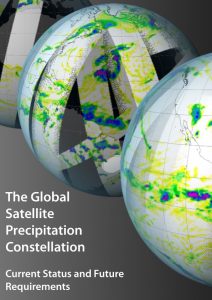The Precipitation Virtual Constellation (P-VC) exists to sustain and enhance a systematic capability to observe and measure global precipitation. These observations are central to understanding the distribution and characteristics of precipitation, its role in the hydrological/water cycle, and its impact on the climate system. Accurate and timely knowledge of global precipitation is needed for improving predictive skills of high-impact weather events such as hurricanes, floods, droughts, and landslides, as well as the management of freshwater resources. The spatial and temporal variability of precipitation necessitates the combination of data from multiple satellites to ensure representative sampling across the range of scales (spatially and temporally) that is required by worldwide research and operational user communities.
P-VC’s strategic objectives that address this aim include:
- Providing a coordination mechanism to harmonize satellite, data processing, and calibration/validation infrastructures for precipitation;
- Serving as a programmatic point of contact for precipitation measurements, addressing issues which go beyond the individual mission programmes;
- Collecting, processing, and delivering data to develop and improve the knowledge and understanding of precipitation (rain and snow) processes, the distribution of precipitation, and the changes in precipitation over time on a global basis;
- Supporting and engaging the scientific and operational user communities.
Background
The 19th CEOS Plenary Meeting, held in 2005, decided that the CEOS Implementation Plan for Space-Based Observations for the Global Earth Observation System of Systems (GEOSS) should identify the space-based observations required by the 10-year implementation plan for GEOSS and propose a process for coordinating different types of Earth observing programmes funded by CEOS Agencies to provide the required observations. CEOS proposed the Virtual Constellations as the new process to fulfill this need, and four pilot constellation studies, including precipitation, were initiated to pioneer and test the concept.
The Japan Aerospace Exploration Agency (JAXA) and the National Aeronautics and Space Agency (NASA) were identified as the lead agencies in the study of the development of a CEOS Precipitation Constellation and charged with drafting a scoping paper to provide a common vision of the scope and objectives of the Precipitation Constellation. It was decided that the goal of the CEOS Precipitation Constellation would be to establish an international framework to guide, facilitate, and coordinate the continued advancements of multi-satellite global precipitation products.
The development of the CEOS Precipitation Constellation is unique in having:
- An existing constellation of precipitation sensors providing unified multi-satellite, multi-sensor global precipitation products for research and applications;
- An international constellation satellite mission, centered upon the Global Precipitation Measurement (GPM) mission with objectives that coincide with the CEOS Precipitation Constellation aims.
For these reasons, the P-VC is able to leverage and build upon the extensive community inputs already implemented for the GPM mission, launched by NASA and JAXA in 2014.
The CEOS Precipitation Constellation activities focus on:
- Comparison of different inter-calibration methods for generating uniform precipitation estimates from diverse types of precipitation sensors
- The evaluations of different multi-sensor precipitation products.
During its planned mission life (2014 onwards), it is envisioned that the GPM mission will realise the goals of the CEOS P-VC, and that the lessons learned from GPM will serve as a to guide to the planning of future P-VC activities.
The Global Satellite Precipitation Constellation: Current Status and Future Requirements
In December 2021, the CEOS Precipitation Virtual Constellation published: “The Global Satellite Precipitation Constellation: Current Status and Future Requirements“, which details the requirements for a robust constellation of satellite sensors capable of capturing and mapping the spatial and temporal variability of precipitation across the Earth’s surface.
Contact Us
Please feel free to contact Co-Chairs Chris Kidd (NASA) & Takuji Kubota (JAXA) for more information about the CEOS Precipitation Virtual Constellation.